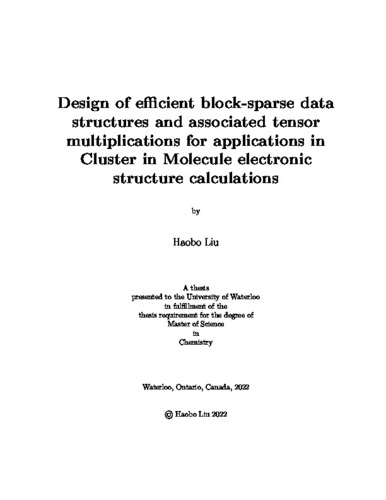| dc.contributor.author | Liu, Haobo | |
| dc.date.accessioned | 2022-08-18 19:13:29 (GMT) | |
| dc.date.available | 2022-08-18 19:13:29 (GMT) | |
| dc.date.issued | 2022-08-18 | |
| dc.date.submitted | 2022-08-16 | |
| dc.identifier.uri | http://hdl.handle.net/10012/18576 | |
| dc.description.abstract | The Cluster-in-molecule approach (CiM) is one of the most popular methods in electronic structure calculations for medium to large molecules and systems. The Nooijen group is currently developing a new CiM approach using the range-separated coulomb potential developed by M. Lecours, however the progress does not reach our expectations as we encountered performance bottlenecks from the two-electron three-index integrals. To deal with this problem, we have implemented two block-sparse data structures named the Tile and the Tile Master to provide sparse matrix storage formats and efficient matrix multiplication algorithms benefiting from the high sparsity of the data. The Tile structure focuses on the efficiency of Sparse-matrix dense-matrix multiplication (SpMM), while the Tile Master emphasizes solving the three-index integral problem using the block-sparse structure and compressed three-dimensional array format. Both the Tile structure and the Tile Master are made highly efficient and able to achieve multi-threading under high parallel structures, including the new Intel KNL structure Xeon processors and any Graphic processing unit (GPU) using the Nvidia Compute unified device architecture cores (CUDA) structures. The benchmarking result indicates that the Tile structure is averaging around 2 to 5 times faster than the NumPy dot algorithm, and up to 30 times faster than our previous Compressed sparse row format (CSR) multiplication routine. The Tile Master on the other hand can compress three-index quantities down almost 95% in storage space using the block-sparse structure, and could handle the calculations efficiently using different dense and sparse calculation routines determined by the Atomic orbital (AO) geometries. To sum up, the Tile structure and the Tile Master will provide useful tools to solve the complex
three-index integral problem in our CiM approach, as well as other scientific calculation problems with sparse matrices involved. | en |
| dc.language.iso | en | en |
| dc.publisher | University of Waterloo | en |
| dc.subject | cluster-in-molecule approach | en |
| dc.subject | range-separated coulomb potential | en |
| dc.subject | sparse-matrix dense-matrix multiplication | en |
| dc.subject | block-sparse structure | en |
| dc.subject | multi-threading programming | en |
| dc.subject | object-oriented programming | en |
| dc.title | Design of efficient block-sparse data structures and associated tensor multiplications for applications in Cluster in Molecule electronic structure calculations | en |
| dc.type | Master Thesis | en |
| dc.pending | false | |
| uws-etd.degree.department | Chemistry | en |
| uws-etd.degree.discipline | Chemistry | en |
| uws-etd.degree.grantor | University of Waterloo | en |
| uws-etd.degree | Master of Science | en |
| uws-etd.embargo.terms | 0 | en |
| uws.contributor.advisor | Nooijen, Marcel | |
| uws.contributor.affiliation1 | Faculty of Science | en |
| uws.published.city | Waterloo | en |
| uws.published.country | Canada | en |
| uws.published.province | Ontario | en |
| uws.typeOfResource | Text | en |
| uws.peerReviewStatus | Unreviewed | en |
| uws.scholarLevel | Graduate | en |

